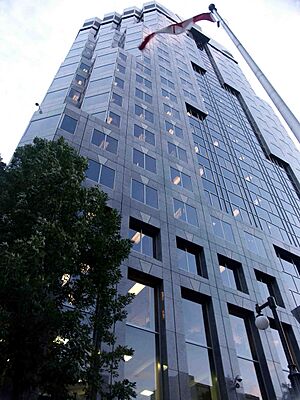AtkinsRéalis facts for kids
|
Trade name
|
AtkinsRéalis |
|---|---|
| Public | |
| Traded as | TSX: ATRL OTC Pink: SNCAF |
| Industry | Engineering, construction, airports, building services, electrical grids, environmental protection & remediation, hydroelectricity, manufacturing, metallurgy, mining, nuclear power, ports, rail transport, roads, water & wastewater |
| Founded | 1911 |
| Founder | Arthur Surveyer |
| Headquarters | Montreal, Quebec, Canada |
|
Key people
|
|
| Products | Engineering services, project management, construction, construction management, procurement and operations and maintenance |
| Revenue | |
|
Number of employees
|
37000 (2023) |
AtkinsRéalis Group Inc. is a big Canadian company based in Montreal. It used to be called SNC-Lavalin Group Inc.. This company helps design, build, and manage large projects around the world. They work in many areas like mining, water, roads, and clean energy.
AtkinsRéalis was Canada's largest construction company by how much money it made in 2021. The company has about 37,000 employees. They have offices in over 50 countries and work in more than 160 countries.
Contents
What AtkinsRéalis Does
AtkinsRéalis works in several important areas. These include buildings, defense, mining, and power. They also work on transportation and water projects.
The company offers many services for these areas. These services include designing projects and studying how they will work. They also help with getting money for projects and managing them. AtkinsRéalis also handles the building, buying materials, and keeping things running.
Building and Transport Projects
AtkinsRéalis builds and manages many types of projects. They work on mass transit systems like trains and subways. They also build highways, bridges, and airports. The company also works on ports and other marine facilities. They design and build industrial, commercial, and healthcare buildings too.
Mining and Power Projects
In the mining world, they help with projects of all sizes. This includes working with mining materials like metals and fertilizers.
For power, AtkinsRéalis helps with many energy projects. They work on systems that send electricity to homes and businesses. They are also involved in hydro power (from water), nuclear power, and renewable energy sources. This includes clean and sustainable power technologies.
How AtkinsRéalis Started
The Early Years: SNC (1911–1991)
The company started in 1911 in Montréal. A man named Arthur Surveyer opened an engineering office. He had studied engineering and worked on public projects.
Arthur Surveyer worked on projects that used electricity. He teamed up with Augustin Frigon, another engineer. In 1912, they worked on a power system for the city of Grand-Mère. A big project for them was designing a hydroelectric power station on the Saint-Maurice River.
The company became known for working with water power and flood control. Soon, they also started working in industries like paper and mining.
In 1937, Surveyer formed a partnership with Emil Nenniger and Georges Chênevert. The company's name later became Surveyer, Nenniger and Chênevert. People soon shortened this name to SNC.
In 1967, Camille A. Dagenais became the head of SNC Group. He led the company until 1975. He was recognized for his work on large water power projects. These projects were in Canada and other countries like India and Greece. One important project was the Manic-5 dam in Quebec. This dam helps produce hydroelectric power. SNC also designed a power station in India in 1963.
Lavalin (1936–1991)
SNC's main competitor in Canada was Lalonde, Valois International Limited. This company was started in 1936 by engineers Jean-Paul Lalonde and Romeo Valois. Bernard Lamarre joined the company in 1952. He later became its director and CEO in 1962.
In 1972, the company changed its name to Lavalin. In the 1970s, Lavalin designed the fabric roof for Montreal's Olympic Stadium. They also helped build the James Bay Project.
By 1986, Lavalin was Canada's largest engineering firm. SNC was the second largest. Both were among the biggest engineering firms in the world. Lavalin also started other businesses. They founded Canadian TV channels like The Weather Network in 1988. By 1990, Lavalin included over 70 companies. But in 1991, SNC bought Lavalin.
SNC-Lavalin (1991–2023)
After the two companies joined, Bernard Lamarre stayed with SNC-Lavalin until 1999. He worked on big projects like the TransCanada highway in Montreal. He also oversaw the Louis-Hippolyte-Lafontaine Bridge-Tunnel.
Bernard Lamarre's younger brother, Jacques Lamarre, became SNC-Lavalin's CEO in 1996. He left this job in 2009.
Growing the Company
SNC-Lavalin worked with Bombardier in the 1990s. They built transportation projects in Malaysia and Turkey. SNC-Lavalin also bought a part of Ontario's Highway 407, a toll road. In 2011, they sold some of their share of Highway 407 and made a good profit.
In 2011, SNC-Lavalin bought the part of Atomic Energy of Canada Limited that built nuclear reactors. They created a new company called Candu Energy. This company sells and supplies CANDU reactors.
In 2014, SNC-Lavalin bought Kentz, an engineering and construction business from Ireland. This helped the company grow even more.
In 2017, SNC-Lavalin bought Atkins, a British design and engineering company. This was a big step for the company.
In 2018, SNC-Lavalin teamed up with ABB, a large industrial company. They formed a new company called Linxon. Linxon designs and builds electrical substations. These are important for power grids.
In 2021, SNC-Lavalin sold its oil and gas business. This included the parts of Atkins and Kentz that worked in oil and gas.
AtkinsRéalis (2023–Present)
On September 13, 2023, SNC-Lavalin announced a new name. The company became AtkinsRéalis. The CEO, Ian Edwards, said the new name combines the Atkins brand. 'Réalis' was inspired by Montreal and the company's French-Canadian roots. It also sounds like "realize," meaning "to make happen." The new name was used right away. The official legal name change will happen after shareholders approve it in 2024.
In 2023, AtkinsRéalis sold its Scandinavian businesses. These were sold to a French engineering company called SYSTRA.
Major Projects in Canada
In 1999, the Ontario government leased Highway 407 to a group of companies, including SNC-Lavalin. This highway was renamed 407 ETR. In the early 2000s, SNC-Lavalin won a contract to fix Montreal's Jacques Cartier Bridge.
In 2002–2003, the company studied the Lac Doré Vanadium Deposit. They found it was the largest vanadium deposit in North America.
In 2005, SNC-Lavalin won a contract to build the Brun-way project. This project made Route 2 in New Brunswick a divided highway. It was finished in 2007. In June 2005, SNC-Lavalin also won a contract to design, build, and operate the William R. Bennett Bridge in Kelowna, British Columbia. This bridge was completed in 2008.
In 2004, the company got the contract for the Canada Line. This is a train system in Vancouver. The project was finished in 2009, earlier than planned.
The Goreway Power Station in Brampton, Ontario, was built by SNC-Lavalin. This large gas-fired power plant started working in 2009. The company also finished building the Ermine Power Station in Saskatchewan in 2009.
In 2010, the company finished building a large hospital. This hospital is part of the McGill University Health Centre.
In 2015, SNC-Lavalin won awards for their work on the Halifax Central Library. They helped create a major building for the city.
SNC-Lavalin also worked on the Eglinton Crosstown and Blue22 train projects in Toronto in 2015. The Blue22 line opened as the Union Pearson Express in 2015. The Eglinton Crosstown line has had delays. SNC-Lavalin is also a partner in the Confederation Line in Ottawa. This is a rapid-transit line with a subway tunnel.
International Projects
In 1995, SNC-Lavalin won a big contract in India. They helped to fix and update hydroelectric power stations for the Indian government.
In 2007, the company won a large contract for the Ambatovy mine in Madagascar. This was the biggest project in Madagascar's history. The mine extracts nickel and cobalt. It was completed in 2010. SNC-Lavalin later sold its share in this project.
In December 2016, the company won a contract in the United States. They built and will operate gas facilities in the Permian shale basin. In March 2016, they also won a contract for a gas processing project in the Middle East.
Major Investors
The Caisse de dépôt et placement du Québec is a very important partner for AtkinsRéalis. The Caisse manages the Quebec Pension Plan. It is one of the largest pension funds in Canada. It has increased its support for companies in Quebec over the years.



